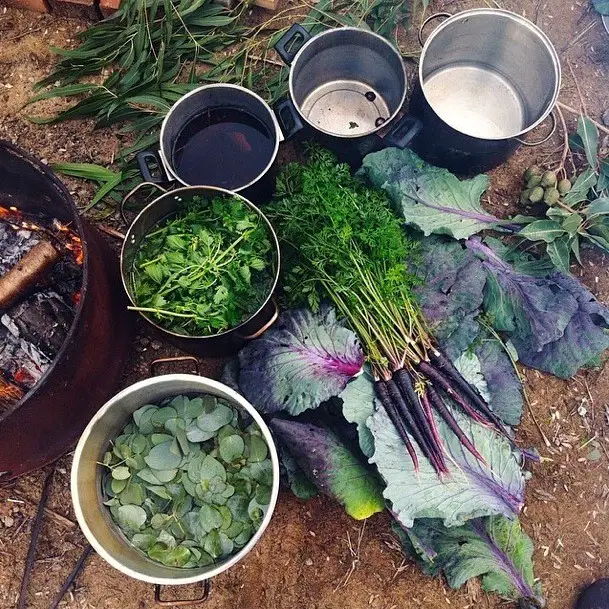This inspiring article on How To Experiment With Plants To Create Beautiful Color Dyes helps you to envision that most fruits, vegetables and wood (bark, leaves and roots) can create a rainbow of color dyes all found in nature.

Here are some examples:
-
Mountain Alder – Inner bark was used to make yellow dye. Outer bark was used to make a flaming red hair dye. Can be mixed with grindstone dust or black earth to make a black dye. Bark was used to wash and restore the brown color to old moccasins.
-
Bloodroot – flower produces red dyes
-
Rubber rabbitbrush
-
Smooth sumac – Leaves can be collected as they fall in the autumn and used as a brown dye. A black and a red dye can be obtained from the fruit. A black dye is obtained from the leaves, bark, and roots. An orange or yellow dye is obtained from the roots harvested in spring. A light yellow dye is obtained from the pulp of the stems.
-
Butternut (Juglans cinerea) -bark from this tree can make a brown dye and young roots to make a black dye. Using an iron mordant, brown dye can be changed to a charcoal or gray color.
-
Rubus – Common names include raspberry, blackberry, blackberry, boysenberry all produce dyes.
-
Yarrow (green, black)
-
Honey Locust (yellow)
-
Golden wild-indigo (green)
-
Tall cinquefoil (black, green, orange, red)
-
Pecan (brown)
-
Indiangrass (brown, green)
-
Western comandra (brown, yellow)
-
Prairie Bluets (brown, yellow)
-
Sassafras (black, green, purple, yellow)
-
Eastern Cottonwood (black, brown, yellow)
-
Plains Coreopsis (black, green, yellow, brown)
-
Ozark chinkapin (black, yellow, brown)
-
Sumac (yellow, green, brown, black)
-
Chokecherry (red)
-
Prairie Parsley (yellow, brown)
-
Slippery Elm (brown, green, yellow)
-
Black Willow (black, green, orange, yellow)
-
Indian blanket (black, green, yellow)
-
Hairy coneflower (brown, green, yellow, black)
-
Red Mulberry (brown, yellow, green)
-
Summer Grape (orange, yellow, black)
-
Black Locust (black, green, yellow, brown)
-
Butterfly milkweed (yellow)
-
Texas Paintbrush (green, red, yellow)
-
Basket flower (yellow)
-
Sagebrush (yellow, gray)
-
Stinging nettle (green)
-
Goldenrod (yellow, brown)
-
Iris (black)
-
Canaigre Dock (yellow, green, brown)
-
Prickly poppy (green, orange, yellow)
-
Downy Phlox (brown, green, yellow)
-
Northern Catalpa (brown, yellow)
-
May-apple (brown, yellow)
-
Sand Evening Primrose (green, orange, red, yellow)
Click here to read How To Experiment With Plants To Create Beautiful Color Dyes:
http://milkwood.net/2014/06/23/experiments-in-colour-diy-plant-dyes/

